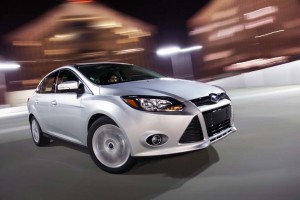
Are buyers starting to shift from small, high-mileage vehicles, like the Ford Focus, back to bigger, less efficient offerings.
A curious thing happened in May: after months of trading in for smaller, more fuel-efficient models, U.S. motorists began to shift back to bigger, less fuel-efficiency vehicles. But was this an anomaly or a significant reversal of recent trends?
By the end of May, according to AAA, gasoline cost about 27 cents a gallon less, on a national average, than it did when prices peaked in early April. Perhaps not so coincidentally, the average fuel economy of new vehicles sold in the U.S. in May – based on their EPA window sticker ratings – slipped to 23.7 miles per gallon, down 0.2 miles per gallon from April, according to statistics compiled by the University Of Michigan.
The drop in the figure reflected the first apparent reversal of the trend towards more fuel-efficient vehicles that had prevailed over the previous six months.
Even after that modest decline, however, May’s average 23.7 mpg figure was up a significant 3.6 mpg, or 18% when compared with the mileage the average American new vehicle was getting in October 2007, which is baseline for the U-M Index and the first month for the university’s monitoring.
The drop in May Index likely reflected the slight reduction in the price of gasoline, U-M officials said.
But other industry analysts also cautioned that other factors might have come into play. Sales of full-sized pickups, such as the Ford F-Series, have also been rising in recent months, even as fuel costs soared towards near-record levels. While the so-called personal-use market for trucks has largely vanished they’re still essential with farmers, contractors and other blue-collar drivers and the increase in demand might have reflected the slow upturn in the overall American economy.
The University of Michigan’s Eco-Driving Index (EDI)–which estimates the average monthly emissions generated by an individual U.S. driver — stood at 0.83 in March 2012, an improvement of 17% since October 2007. The EDI takes into account both vehicle fuel economy and distance driven, which relies on data that are published with a two-month lag.
The unadjusted CAFE performance in May was 29.1 mpg, an improvement of 4.4 mpg (or 18%) since October 2007. This index is based on a different set of EPA ratings than the values motorists see on a new vehicle’s window sticker.
Paul A. Eisenstein contributed to this report.
